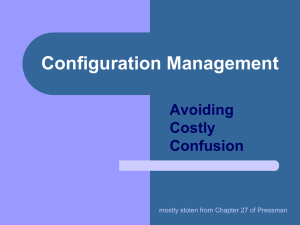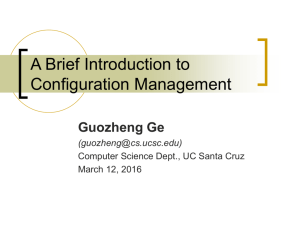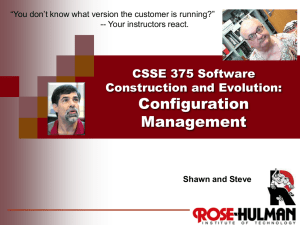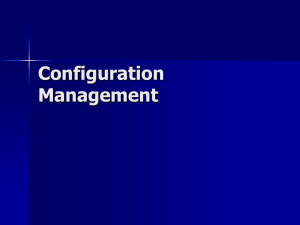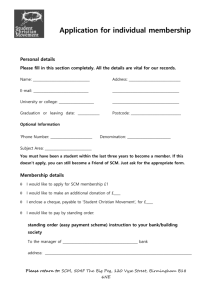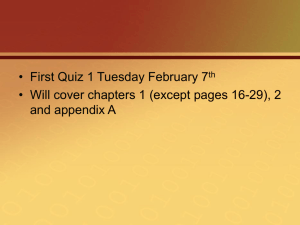Configuration Management
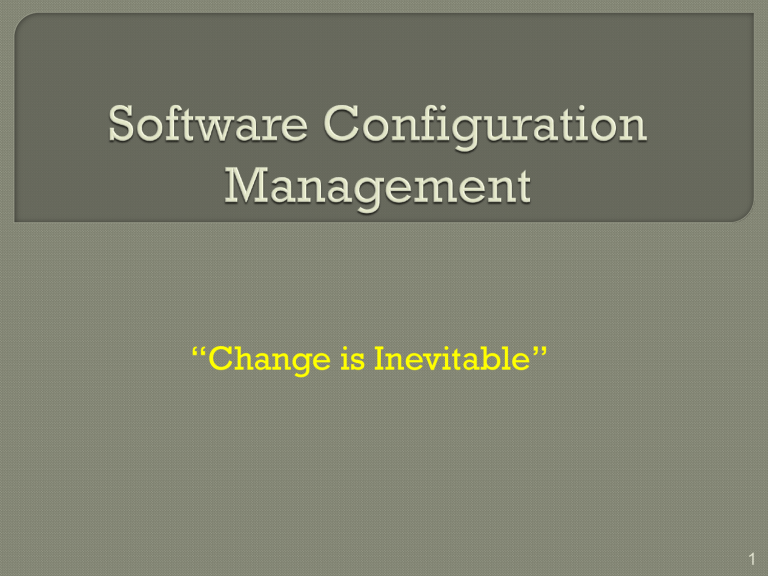
“Change is Inevitable”
1
The art of coordinating software development to minimize confusion is called configuration management.
Configuration management is the art of identifying, organizing, and controlling modifications to the software being built by a programming team.
The goal is to maximize productivity by minimizing mistakes.
2
Software configuration management (SCM) is an umbrella activity that is applied throughout the software process.
Because change can occur at any time, SCM activities are developed to
1.
2.
3.
4.
Identify change,
Control change,
Ensure that change is being properly implemented
Report changes to others who may have an interest.
3
“ If you don’t control change, it controls you. ”
A stream of uncontrolled changes may turn a well-run software project into chaos.
SCM is an essential part of good project management and solid software engineering practice.
4
People come to know more about it, as time passes.
Most changes are justified.
First Law of System Engineering states:
“ No matter where you are in the system life cycle, the system will change, and the desire to change it will persist throughout the life cycle.
”
5
The items that comprise all information produced as part of the software process are collectively called a software configuration.
Software Configuration Items (SCI)
• Computer programs
•
•
both source level and executable forms
Documents (that describe the computer programs)
targeted at both technical practitioners and users
Data
contained within the program or external to it
6
New business or market conditions
Customer’s new needs
• Or New Customer’s needs
Reorganization or business growth/downsizing
Budgetary or scheduling constraints
…….
7
A baseline is a software configuration management concept that helps us to control change without seriously impeding justifiable change.
•
Definition :
“ A specification or product that has been formally reviewed and agreed upon, that there-after serves as the basis for further development, and that can be changed only through formal change control procedures.”
8
Creation of a baseline is usually a milestone in the schedule.
The baseline is centrally controlled.
Everyone uses the same current baselines.
To change the baseline requires a formal process.
9
10
*Validation
*Verification
11
Versioning
Dependency Tracking and Change Management
Requirements Tracing
•
•
Forward Tracking : Ability to track all the design components and deliverables that result from a specific requirement
Backward Tracking : Ability to identify which requirement generated any given deliverable
Configuration management
• keeps track of a series of configurations representing specific project milestones or production releases.
Audit trails
• establishes additional information about when, why, and by whom changes are made.
12
SCM Tasks
•
•
•
•
• Identification
How does an organization identify and manage the many existing versions of a program (and its documentation) in a manner that will enable change to be accommodated efficiently?
Version Control
How does an organization control changes before and after software is released to a customer?
Configuration Auditing
Who has responsibility for approving and ranking changes?
Change Control
How can we ensure that changes have been made properly?
Reporting
What mechanism is used to appraise others of changes that are made?
13
14
- Follow CM to “Avoid costly confusions”
15
1.
Change Request is made
2.
Request is Approved or Denied
3.
"Check Out" the item(s)
4.
Make Changes
5.
Testing or Reviews
formal review of design changes,
regression testing of modules, etc
6.
Review the Change Order
7.
Notify all Dependencies
when baseline change will occur
what changes were made to baseline
8.
"Check In" the new baseline
16
Name, Date, yadda yadda
Type of change
Goal of making the change
Priority / Urgency
Detailed description of the changes
Expected Effects
Timetable for making changes, testing, release,
Estimated Costs
17
% of unapproved changes
% of Change Orders completed on schedule
% of affected Configuration Items that were not checked
% of properly documented Configuration
Items
number of CM Process Failures
18
How do we keep track of all these versions, dependencies among components, approval records, etc. etc. etc., and still assure quality?
Have a Sound CM Procedure
Use Good CM Tools
19
1. Introduction a) purpose b) scope c) definitions and acronyms d) references
2. Management a) organization
IEEE Standard 828 - standard for
Software Configuration Management Plans b) SCM responsibilities c) interface control d) SCMP implementation e) policies, directives, procedures (naming conventions, version designations, problem report process)
3. SCM Activities a) configuration identification b) configuration control (change history, review authority, read/write control, member identification) c) configuration status accounting (status of requests, status of approved changes,
…) d) audits and reviews
4. Tools, Techniques, and Methodologies
5. Supplier Control
6. Records Collection and Retention
According to
20
Defines terms, such as baseline and version
Discusses configuration management as a management discipline and its role in the engineering process
Includes checklists of issues for sections of the SCMP (IEEE Std 828)
Includes four complete examples of SCMPs
21
Dependency Tracking!!!
Audit Trails!!!
Reporting of Changes
Supports the Change Rules
Versioning
Requirements Tracing
Repository arranged as "basic objects" and "aggregate objects"
Supports both Linear evolution and Trees
22
Controlled Document - a document that is currently vital or may become vital for development and maintenance.
Galin page 389
Hence, its preparation and storage is an
SQA issue.
23
Definition of the list of Controlled
Documents
Document preparation requirements
Document approval requirements
Document storage, retrieval, and versioning
Galin page 391
24
Software Code
Data
test data
database files
Documents
SRS
designs
project schedules
test plans, test results
…
Standard Term:
"Configuration Item"
25
Data Integrity
• Ensure consistency
• Perform “Cascading”
Information Sharing
• Share information among multiple developers
• Lock & unlock objects to avoid adverse changes
Tool Integration
• tool integration establishes a data model that can be accessed by all tools
• controls access to the data
Other obvious functions of a DBMS
26
